My Journey as an Aztec Validator
What it's really like to run an Aztec validator when you're still figuring things out
How I Actually Became a Validator (It Wasn't What You'd Expect)
Let me be honest - I didn't wake up one day and think "I want to secure a privacy-focused blockchain network." My path to becoming an Aztec validator was more... lucky.
I'd been exploring various blockchain projects for months, mostly as a curious observer. Reading whitepapers, testing applications, lurking in Discord channels. When I discovered Aztec's approach to privacy and their hybrid execution model, something clicked. This wasn't just another "privacy coin" or mixer solution. This was a fundamentally different way of thinking about blockchain architecture.
So I joined their Discord, started following the discussions, asking questions, trying to understand the technology better.
The Lucky Break: Winning a Quiz in #guardian-channel (With Screenshots to Prove It)
Here's the part that sounds too good to be true, but I swear it happened exactly like this - and I have the screenshots to prove it.
I was hanging out in Aztec's Discord, specifically in the #guardian-channel where they discuss validator-related topics. The team occasionally runs quizzes about the protocol - testing whether people actually understand the technology or are just there for potential rewards.
One day in early May 2025, Amin (one of the core team members) posted a quiz that looked like this:
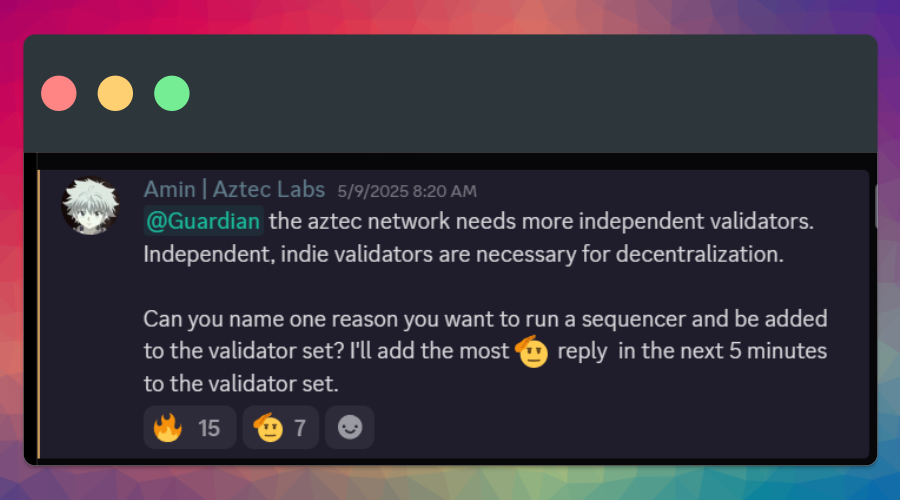
The actual quiz that changed my validator status - Amin asking about Aztec's technical details
I'd been reading their documentation obsessively, so I felt confident about my answers. Here's what I submitted:
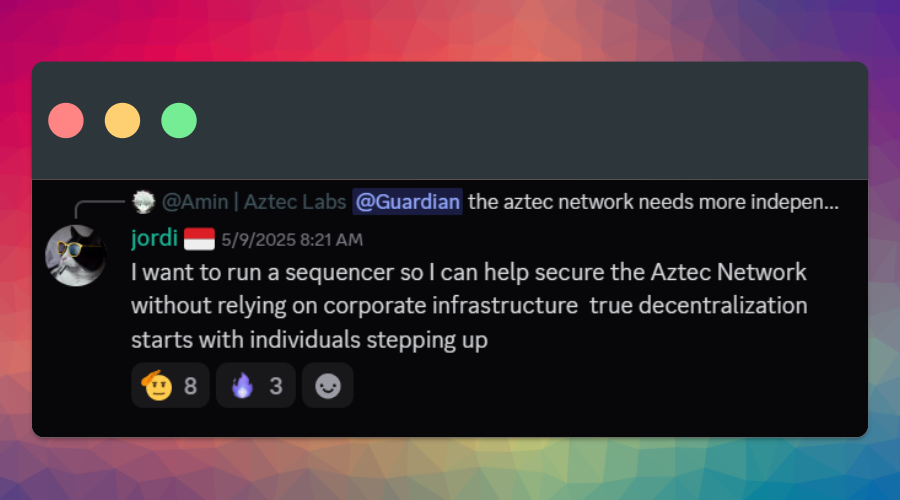
My responses to the quiz - trying to sound knowledgeable while secretly hoping I wasn't completely wrong
Plot twist: Claire (another core team member) actually liked my answer!
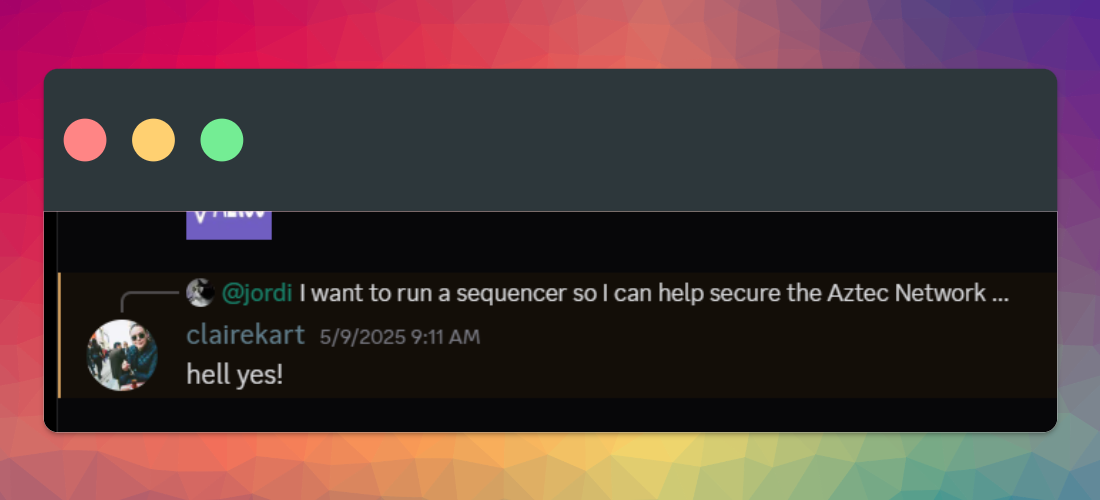
Claire's reaction to my quiz response - this is when I knew I might actually have a chance
Then came the magical DM from Amin asking for my validator address:
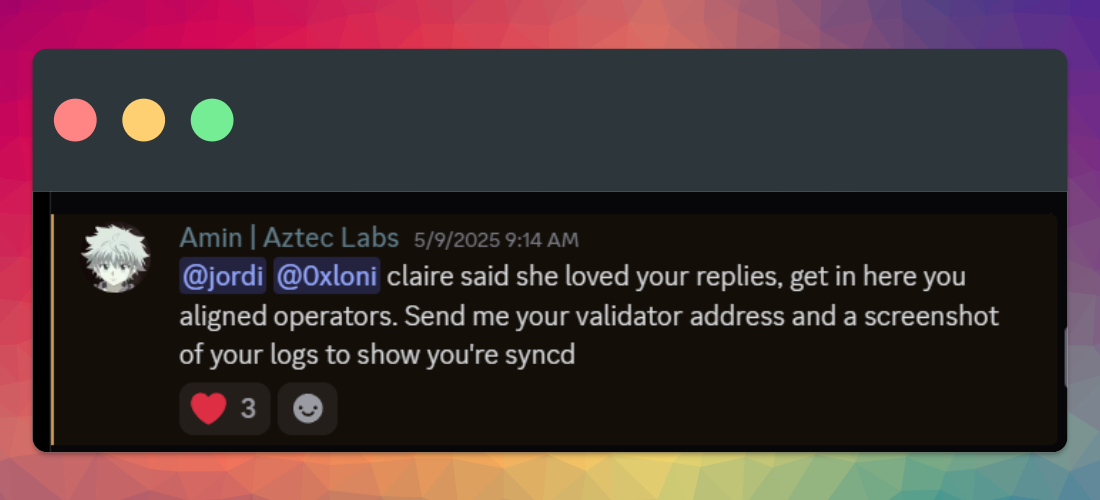
The DM that made it real - "paste your validator address" and just like that, I was in epoch 46
My reaction: "Wait, what? That's it? I just... paste an address and become a validator?"
Why This Quiz Format Was Brilliant
Looking back, this whole experience was both weird and wonderful. Here's why I think Amin and the team nailed it:
It felt organic: No formal application process, no waiting for announcements. Just a spontaneous quiz in Discord chat during what felt like a regular community discussion.
It tested actual knowledge: The questions weren't generic "what's your favorite feature" type stuff. They required understanding of Aztec's specific technical approach and how it differs from other privacy solutions.
It created community energy: Everyone in the channel was participating, discussing answers, and learning from each other. It turned validator selection into a fun, educational group activity rather than a competitive race.
It was... kind of funny: The casual nature of becoming a validator through Discord DM still makes me laugh. "Hey, paste your address and you'll secure a blockchain network" is peak crypto culture. I half expected there to be more paperwork involved, or at least a terms of service to sign. Nope - just a Discord DM. 😄
The Timing Was Perfect
This happened when I joined at epoch 46, during Aztec's phase of carefully selecting validators who understood the technology. The quiz format meant they could:
- Test technical knowledge in real-time
- See how people engaged with the community
- Select validators who were actively learning and participating
- Keep the process accessible (no massive capital requirements or technical barriers)
The whole thing felt like being invited to join a really cool group project, rather than applying for a job or competing in a cutthroat selection process.
Starting Out: May 9th, 2025
I remember the exact date I became an active validator: May 9th, 2025. Not because I'm obsessive about dates, but because it was one of those "holy shit, it actually worked" moments that stick with you.
One minute I'm just another Discord lurker trying to learn about privacy-focused blockchain architecture. The next minute, Amin is adding my validator address to the active set because I correctly answered some quiz questions.
The setup process was surprisingly straightforward. No complicated staking mechanisms, no minimum requirements that would bankrupt a college student, no "you need to know someone" barriers to entry. I literally just had to paste my address in Discord and boom - I'm a validator.
What this taught me about Aztec: They're serious about decentralization, but they also want validators who actually understand the technology. The quiz wasn't trivial - it required genuine knowledge of how their privacy model works, what makes their approach different, and how the consensus mechanism functions. It wasn't just "follow us on Twitter and retweet" type questions.
This approach impressed me. They could have just opened validator slots to whoever had the most capital or the fastest fingers. Instead, they rewarded people who took time to learn about the protocol.
The Economics: What Running an Aztec Validator Actually Costs
Let me break down the real costs of participating in the Aztec network, because this is something I wish more people talked about honestly.
Hardware Costs
- VPS: $40/month for a decent setup (4 cores, 8GB RAM, 200GB SSD)
- Bandwidth: Usually included in VPS costs, but you'll use about 100GB/month
- Total monthly hardware cost: ~$40
Compare this to:
- Ethereum validator: $80-120/month minimum
- Solana validator: $200+ for competitive hardware
- Most Cosmos validators: $60-100/month
Time Investment
This is where Aztec really shines. I spend maybe 2-3 hours per month on maintenance. That includes:
- Checking logs once a week
- Updating when new versions come out (maybe monthly)
- Monitoring performance occasionally
My Ethereum validators? I was spending 5-10 hours per month just keeping up with updates and troubleshooting.
Economic Incentives
Here's the thing about Aztec's economic model - it's designed to be sustainable without requiring massive capital investment or energy consumption. You're not competing with mining farms or whales with millions in stake.
Real Talk: I'm not getting rich running an Aztec node, but I'm covering my costs and contributing to a network I believe in. Sometimes that's enough.
My Active Validator Period: May 9 - July 20, 2025
I was part of the active validator set from May 9th through July 20th, 2025 - nearly 2.5 months of consistent participation before the adversarial testnet transition.
Here's a screenshot of my actual validator performance from the Sepolia explorer, showing consistent block production throughout my active period:
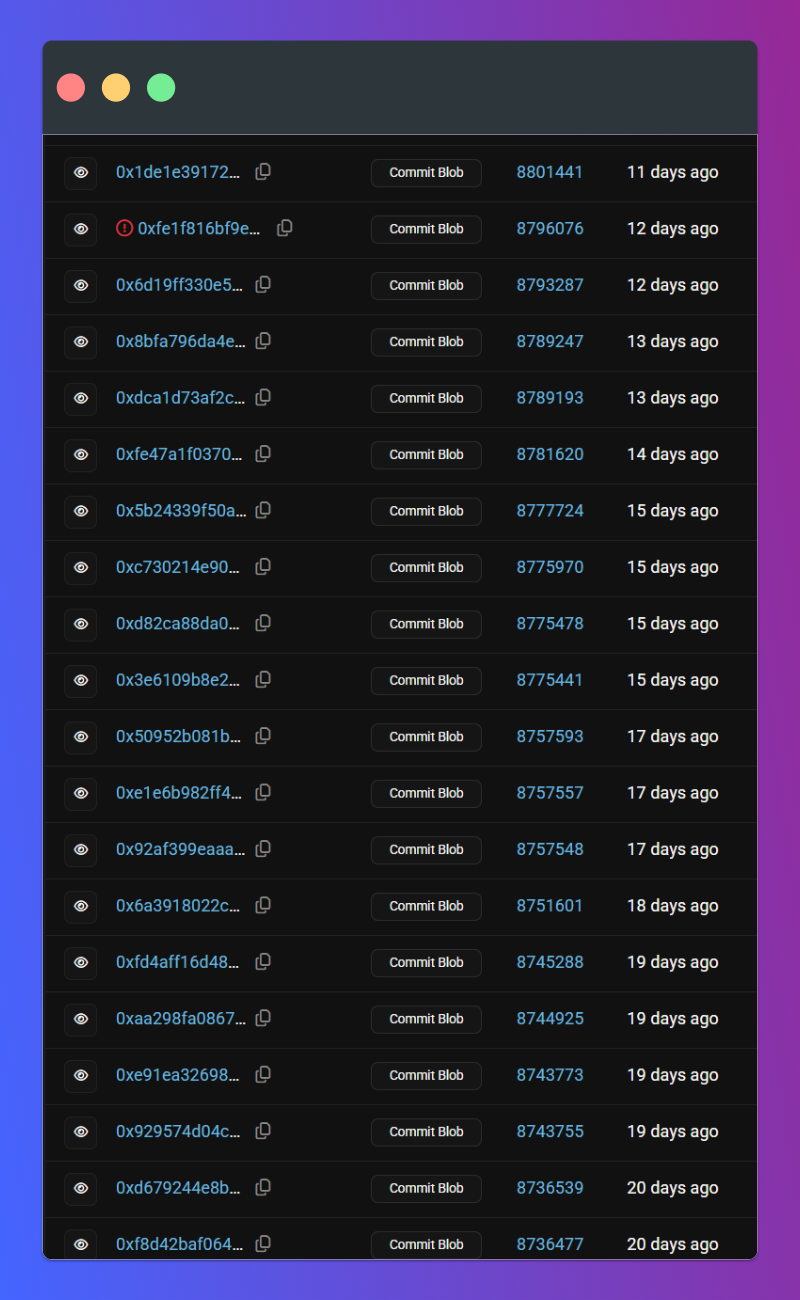
My validator's block production history on Sepolia testnet - you can see the consistent activity from May 9th through July 20th, 2025
Final Performance Stats (Before Adversarial Testnet)
So here's how I actually did during my 2.5 months as an active validator. Got these numbers from @aztec_seer_bot (EmberStake's bot) on Telegram:
- Total Slots Participated: 5,622
- Attestation Success Rate: 92.12% (5,028 successful, 430 missed)
- Proposal Miss Rate: 1.22% (only 2 missed proposals)
- Status: Active in validator set (until July 20th)

Screenshot from @aztec_seer_bot showing my actual validator stats - honestly this bot saved me so much time tracking everything
About this bot: @aztec_seer_bot from EmberStake is honestly a lifesaver for tracking validator stuff. It shows you:
- How many attestations you're actually hitting (vs missing)
- Your proposal stats and any you've missed
- Where you are in the queue and estimated wait times
- How you stack up against other validators
- Network-wide stats so you can see the bigger picture
- Probably slashing info too once the adversarial testnet is fully running (I'm still in queue, so can't confirm this yet)
The missed attestations? Mostly during the early weeks when I was still figuring out optimal configurations. Once I got my setup dialed in, I was hitting attestations consistently.
The Learning Curve: What I Wish I'd Known
Week 1: Everything is Confusing
My first week was a mess. I understood the basic concepts, but translating that into actual node operation was different. Questions like:
- What are the optimal hardware settings?
- How do I monitor performance effectively?
- What do these error messages actually mean?
Week 2-3: Things Start Clicking
By the second week, I was getting comfortable with the basic operations. The Aztec documentation is actually pretty good, and the community Discord was incredibly helpful for troubleshooting.
Month 1-2: Finding My Rhythm
After the first month, running the validator became routine. Check logs, monitor performance, update when needed. The learning curve levels off, and you start understanding the network's behavior patterns.
Month 2-3: Actually Understanding What I'm Doing
By the third month, I wasn't just following instructions - I understood why I was doing things. I could troubleshoot issues independently and even help other new validators in Discord.
The Adversarial Testnet Transition: Plot Twist!
Here's where the story gets interesting. Just when I was getting comfortable with my validator performance, Aztec announced they were transitioning to an "Adversarial Testnet." My active validator period ended on July 20th, 2025, and suddenly everyone had to re-queue for the new testnet phase.
August 1st, 2025 - I'm back in queue at position 3,808 out of 4,976 total validators waiting to join the adversarial testnet. The interface shows "3 days average wait time" - but let's be real, that's not how math works when you're at position 3,808.
Here's the actual queue status showing thousands of validators (including myself) waiting to join the adversarial testnet:
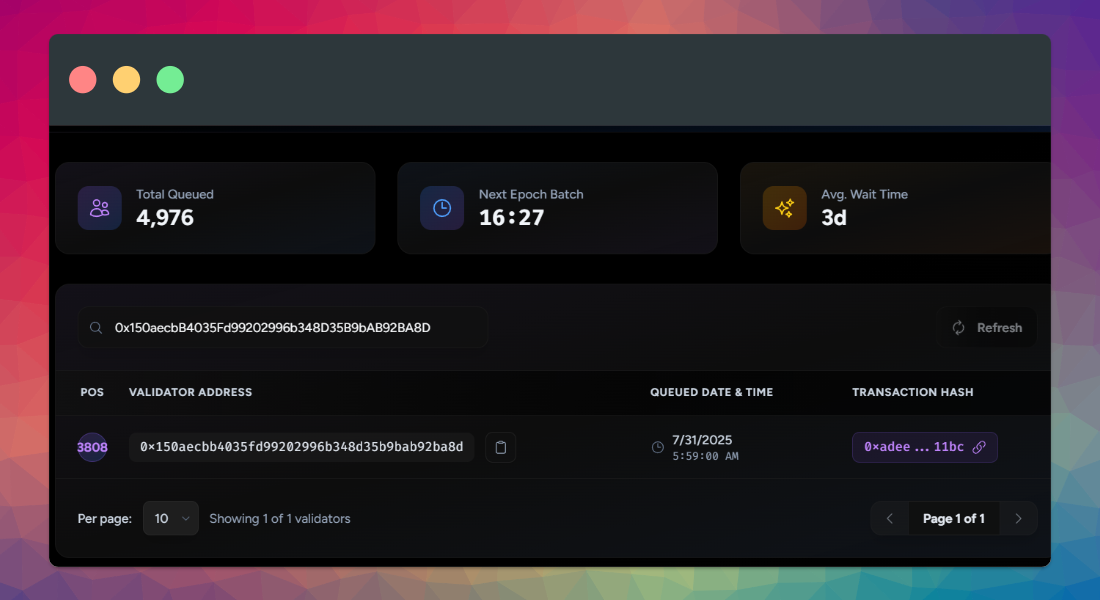
Position 3808 out of 4,976 validators in queue - the demand to participate again speaks volumes about community confidence in the project
My first reaction: "Great, back to square one." My second reaction: "Actually, this is brilliant."
The Adversarial Testnet Goes Live: When Decentralization Gets Real
Fast forward to the official launch announcement:
"Adversarial Testnet is LIVE: Compete, Create, and Gather in the Town Hall 🚨
Aztec's Public Testnet has entered its most critical phase: the Adversarial Testnet. This is your chance to help shape the future of decentralized, privacy-preserving smart contracts. We're streamlining validator queue entry via ZKPassport, launching community town halls, and tracking node performance live on Dashtec.
🥷 Slashing, decentralized governance, and global competition are now in play, the network's future is in your hands."
My immediate thought: "This is it! This is what I've been waiting for!"
My second thought: "Wait... ZKPassport? What's a ZKPassport?"
The Passport Problem (AKA Why I'm Still in Queue)
Here's where the story gets both frustrating and funny. The Adversarial Testnet launched with a new process: ZKPassport for verified queue entry. It's a cool privacy-preserving identity system that lets you prove you're a unique human without revealing personal information.
The problem: I don't have one yet.
The process now:
- Have ZKPassport? You can join the queue directly with verification using your real passport
- No ZKPassport? Fill out a form and wait for the team to manually add you to the queue
The reality: I'm back to position 3,808 out of 4,976 validators, watching as the network adds approximately 75 new validators per day.
Quick math: 3,808 ÷ 75 = roughly 51 days of waiting 😅
The UI's math: "3 days average wait time"
My math: "Uhh, that doesn't seem right..." 🤔
Why I'm Not (That) Mad About It
You'd think I'd be frustrated. I was an active validator for months, proved I could run a stable node, contributed to the community, and now I'm back in a 50+ day queue because I don't have the right digital passport?
But honestly? This is exactly the kind of problem-solving I want to see from the Aztec team.
They could have just reopened the validator set to anyone with a pulse and enough hardware. Instead, they're:
- Testing identity systems that will be crucial for mainnet
- Streamlining the queue process while preventing Sybil attacks through ZKPassport
- Maintaining fair access by not giving automatic priority to previous validators
- Stress testing governance with real slashing conditions and community decision-making
The New Game Rules: Slashing, Governance, and Competition
This isn't your grandpa's testnet anymore. The Adversarial Testnet includes:
- Real slashing conditions: Bad validators get penalized
- Decentralized governance: Community actually makes decisions
- Live performance tracking: Your validator performance is public on Dashtec - the monitoring platform for all Aztec network activity
- Global competition: Leaderboards, challenges, and community recognition
Most testnets are designed to make everything work smoothly. You run your node, earn some testnet tokens, everything is peachy. But that's not how real networks behave.
Aztec's adversarial testnet is designed to break things on purpose. They're testing how the network handles malicious validators, network attacks, Byzantine failures, and stress conditions.
As someone who's seen networks fail spectacularly in production (looking at you, various Cosmos chains during major upgrades), this proactive approach to testing edge cases is refreshing.
Being in that queue at position 3,808? It's not frustrating - it's validating. It means there are thousands of other operators who, like me, believe in this project enough to queue up again and wait their turn, even when the rules changed.
The Community Aspect That Actually Matters
Here's something I didn't expect: the Aztec community is genuinely helpful without being cultish.
When I was troubleshooting attestation misses in June, I posted in their Discord at like 2 AM (my timezone). Within 20 minutes, I had responses from both community members and core team members. Not generic "RTFM" responses, but actual debugging help.
The team is incredibly active. I've seen protocol developers in Discord channels helping individual node operators troubleshoot setup issues. When's the last time you saw Vitalik personally helping someone debug their Ethereum node configuration?
Real Examples of Community Help
Problem: My validator was missing attestations randomly, couldn't figure out why. Solution: Community member suggested checking my system clock sync. Turns out my VPS had slight time drift that was causing issues.
Problem: Node kept crashing after a client update. Solution: Core team member jumped in Discord, helped me debug logs, and identified a configuration conflict.
Problem: Confused about economic incentives and whether running a validator was worth it. Solution: Multiple validators shared their experiences and honest cost breakdowns.
What This Experience Taught Me
Running a validator gives you a different perspective on a protocol. You're not just using it - you're helping secure it, you're invested in its success, you're seeing how it behaves under real conditions.
A few things became clear during my months as an Aztec validator:
- The technology actually works: My validator ran stable for months with minimal intervention
- The team is building for the long term: The adversarial testnet transition shows they're thinking about real-world attack scenarios, not just happy path testing
- The economic model is sustainable: I never felt like I was competing with whales or mining farms
- The community is genuine: When people are helping each other troubleshoot at 2 AM, that's a community worth being part of
Advice for Other Aspiring Validators
If you're considering running an Aztec validator and you're new to node operations (like I was), here's my honest advice:
Start Small
- Use the sandbox first: Get comfortable with the tooling before staking real value
- Budget conservatively: Start with the minimum viable setup, upgrade later if needed
- Join the Discord: The community is your best resource for learning
Expect a Learning Curve
- First week will be confusing: That's normal, push through it
- Document your setup: You'll thank yourself later when you need to troubleshoot
- Ask questions: The community is helpful, but you need to ask specific questions
Think Long Term
- This isn't a get-rich-quick scheme: You're contributing to network security, not mining gold
- Technology is still evolving: Expect changes, updates, and transitions like the adversarial testnet
- Focus on learning: The experience and knowledge are often more valuable than immediate rewards
The Current Wait: What I'm Doing While Slowly Moving Up the Queue
As I write this, I'm still waiting in the adversarial testnet queue. Position 3,808 and counting down by approximately 75 spots per day. At this rate, I'll be back in the active set sometime around... checks calculator ... mid-September?
The queue interface keeps showing optimistic estimates like "3 days average wait" but when you're at position 3,808 and only 75 validators get added daily, that's more like 50+ days. Either the UI is being very optimistic, or there's some queue magic I don't understand yet.
But honestly, I'm not just sitting idle refreshing the queue position (okay, maybe I check it more often than I should).
I'm using this time to:
- Get that ZKPassport sorted: Because clearly I need to get with the times
- Improve my monitoring setup: Learning more about Dashtec and how performance tracking works - it monitors all validator activity, attestations, queue positions, proposals, and network metrics
- Study the adversarial testnet docs: Understanding slashing conditions and governance mechanics
- Help other validators: Sharing what I learned during my active period, especially with newcomers who are as confused as I was
- Watch the drama unfold: The adversarial testnet has real slashing now, so there's actual validator drama to observe
The Silver Lining of Being in Queue
There's something oddly comforting about being in this massive queue with 4,976 other validators. It's like being in line for a really popular restaurant - frustrating, but also validating that you're trying to get into something worthwhile.
Plus, watching 75 validators get added daily means I get to see how the network performs under real stress conditions before I'm responsible for contributing to that performance. It's like getting a preview of what I'm signing up for.
The queue anxiety is real though: Every day I wonder if I'll drop down 75 positions, or if something will go wrong and I'll drop even further. It's like being in a very slow-moving, very nerdy battle royale.
Looking Forward
The adversarial testnet represents a new phase of learning. Running a validator during normal operations taught me the basics. Running during adversarial conditions? That's going to teach me how to handle the unexpected.
I'm excited to see how the network performs under stress, how the community responds to challenges, and what I'll learn about both the technology and myself as an operator.
Final Thoughts for Fellow Newbies
If you're reading this and thinking about becoming an Aztec validator, here's the truth: you don't need to be an expert to start. You just need to be willing to learn.
My 92% success rate wasn't because I knew everything from day one. It was because I was willing to ask questions, learn from mistakes, and iterate on my setup.
The Aztec network needs validators who care about the technology and are committed to learning. Technical expertise can be developed - commitment and curiosity are harder to teach.
If you have those qualities, the rest will follow.
Author's Note
This is my authentic experience as an Aztec validator, documented with real performance data, screenshots, and personal insights. While I occasionally used AI tools for technical clarification and DeepL for translation assistance, all experiences, validator statistics, Discord interactions, and opinions shared here are genuinely mine.
Currently waiting in the adversarial testnet queue and documenting the journey. Find me on Twitter or GitHub if you want to discuss validator operations or share experiences.